Analysis of Investment Decisions: NPV, Payback, and Financial Factors
VerifiedAdded on 2023/01/11
|7
|1424
|95
Essay
AI Summary
This essay analyzes business decision-making for XYZ Plc, a budget hotel chain, evaluating investment in a software or laundrette project. The analysis utilizes Net Present Value (NPV) and payback period calculations to assess the profitability of each project, considering cash flows over a five-year period. The NPV analysis reveals that the laundrette project (Project B) has a higher present value than the software project (Project A). The payback period analysis shows both projects recover their initial investments in roughly the same timeframe, with Project A slightly quicker. Beyond these tools, the essay considers financial factors like interest and economic growth rates and non-financial factors such as industry stability and legislation. The conclusion recommends investing in Project B (laundrette) due to its higher profitability and efficient return on investment, aligning with the company's strategic goals for growth and development.

Business Decision Making
Paraphrase This Document
Need a fresh take? Get an instant paraphrase of this document with our AI Paraphraser

Contents
ESSAY TOPIC................................................................................................................................1
ESSAY BODY................................................................................................................................1
Introduction..................................................................................................................................1
Main body....................................................................................................................................1
Conclusion...................................................................................................................................4
REFERENCES................................................................................................................................5
ESSAY TOPIC................................................................................................................................1
ESSAY BODY................................................................................................................................1
Introduction..................................................................................................................................1
Main body....................................................................................................................................1
Conclusion...................................................................................................................................4
REFERENCES................................................................................................................................5
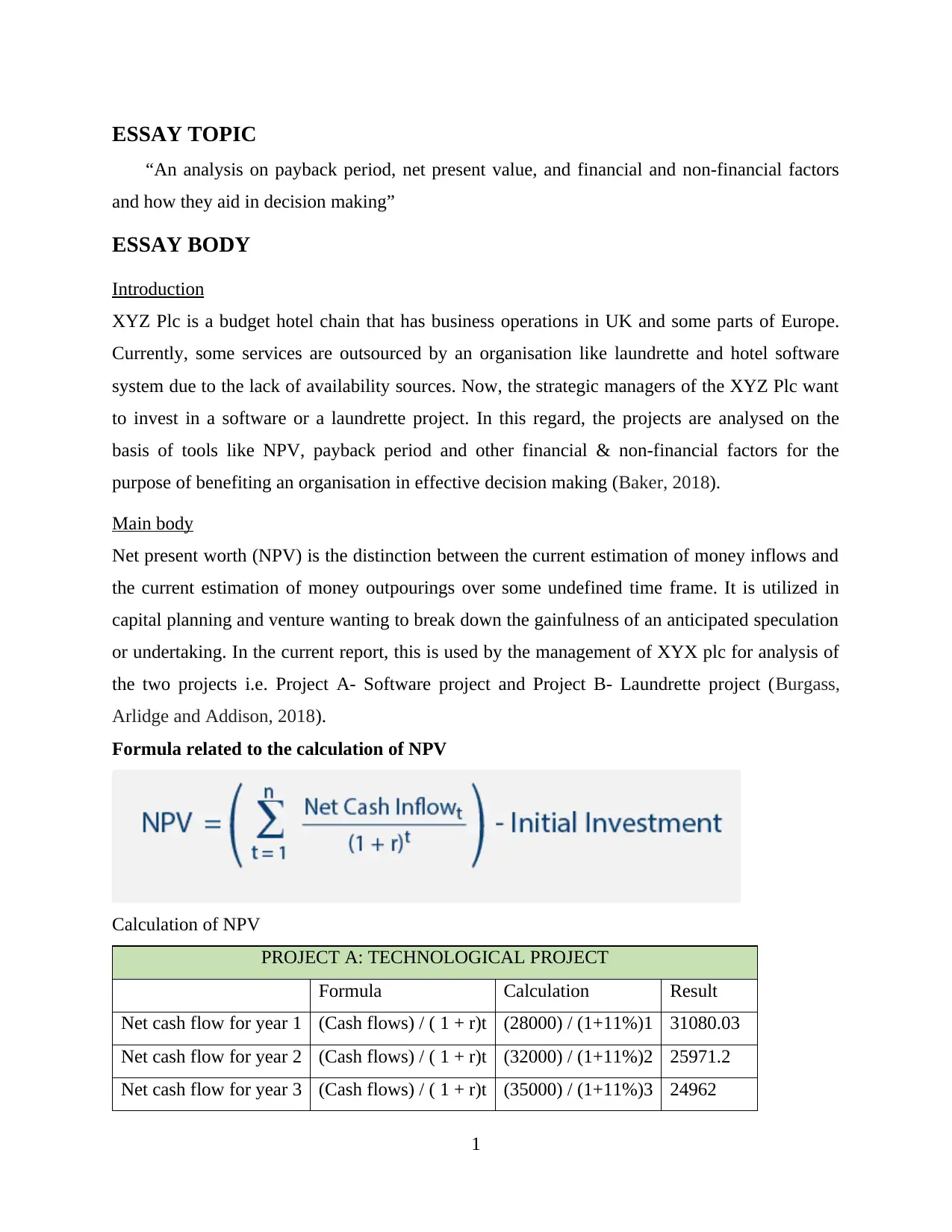
ESSAY TOPIC
“An analysis on payback period, net present value, and financial and non-financial factors
and how they aid in decision making”
ESSAY BODY
Introduction
XYZ Plc is a budget hotel chain that has business operations in UK and some parts of Europe.
Currently, some services are outsourced by an organisation like laundrette and hotel software
system due to the lack of availability sources. Now, the strategic managers of the XYZ Plc want
to invest in a software or a laundrette project. In this regard, the projects are analysed on the
basis of tools like NPV, payback period and other financial & non-financial factors for the
purpose of benefiting an organisation in effective decision making (Baker, 2018).
Main body
Net present worth (NPV) is the distinction between the current estimation of money inflows and
the current estimation of money outpourings over some undefined time frame. It is utilized in
capital planning and venture wanting to break down the gainfulness of an anticipated speculation
or undertaking. In the current report, this is used by the management of XYX plc for analysis of
the two projects i.e. Project A- Software project and Project B- Laundrette project (Burgass,
Arlidge and Addison, 2018).
Formula related to the calculation of NPV
Calculation of NPV
PROJECT A: TECHNOLOGICAL PROJECT
Formula Calculation Result
Net cash flow for year 1 (Cash flows) / ( 1 + r)t (28000) / (1+11%)1 31080.03
Net cash flow for year 2 (Cash flows) / ( 1 + r)t (32000) / (1+11%)2 25971.2
Net cash flow for year 3 (Cash flows) / ( 1 + r)t (35000) / (1+11%)3 24962
1
“An analysis on payback period, net present value, and financial and non-financial factors
and how they aid in decision making”
ESSAY BODY
Introduction
XYZ Plc is a budget hotel chain that has business operations in UK and some parts of Europe.
Currently, some services are outsourced by an organisation like laundrette and hotel software
system due to the lack of availability sources. Now, the strategic managers of the XYZ Plc want
to invest in a software or a laundrette project. In this regard, the projects are analysed on the
basis of tools like NPV, payback period and other financial & non-financial factors for the
purpose of benefiting an organisation in effective decision making (Baker, 2018).
Main body
Net present worth (NPV) is the distinction between the current estimation of money inflows and
the current estimation of money outpourings over some undefined time frame. It is utilized in
capital planning and venture wanting to break down the gainfulness of an anticipated speculation
or undertaking. In the current report, this is used by the management of XYX plc for analysis of
the two projects i.e. Project A- Software project and Project B- Laundrette project (Burgass,
Arlidge and Addison, 2018).
Formula related to the calculation of NPV
Calculation of NPV
PROJECT A: TECHNOLOGICAL PROJECT
Formula Calculation Result
Net cash flow for year 1 (Cash flows) / ( 1 + r)t (28000) / (1+11%)1 31080.03
Net cash flow for year 2 (Cash flows) / ( 1 + r)t (32000) / (1+11%)2 25971.2
Net cash flow for year 3 (Cash flows) / ( 1 + r)t (35000) / (1+11%)3 24962
1
⊘ This is a preview!⊘
Do you want full access?
Subscribe today to unlock all pages.

Trusted by 1+ million students worldwide
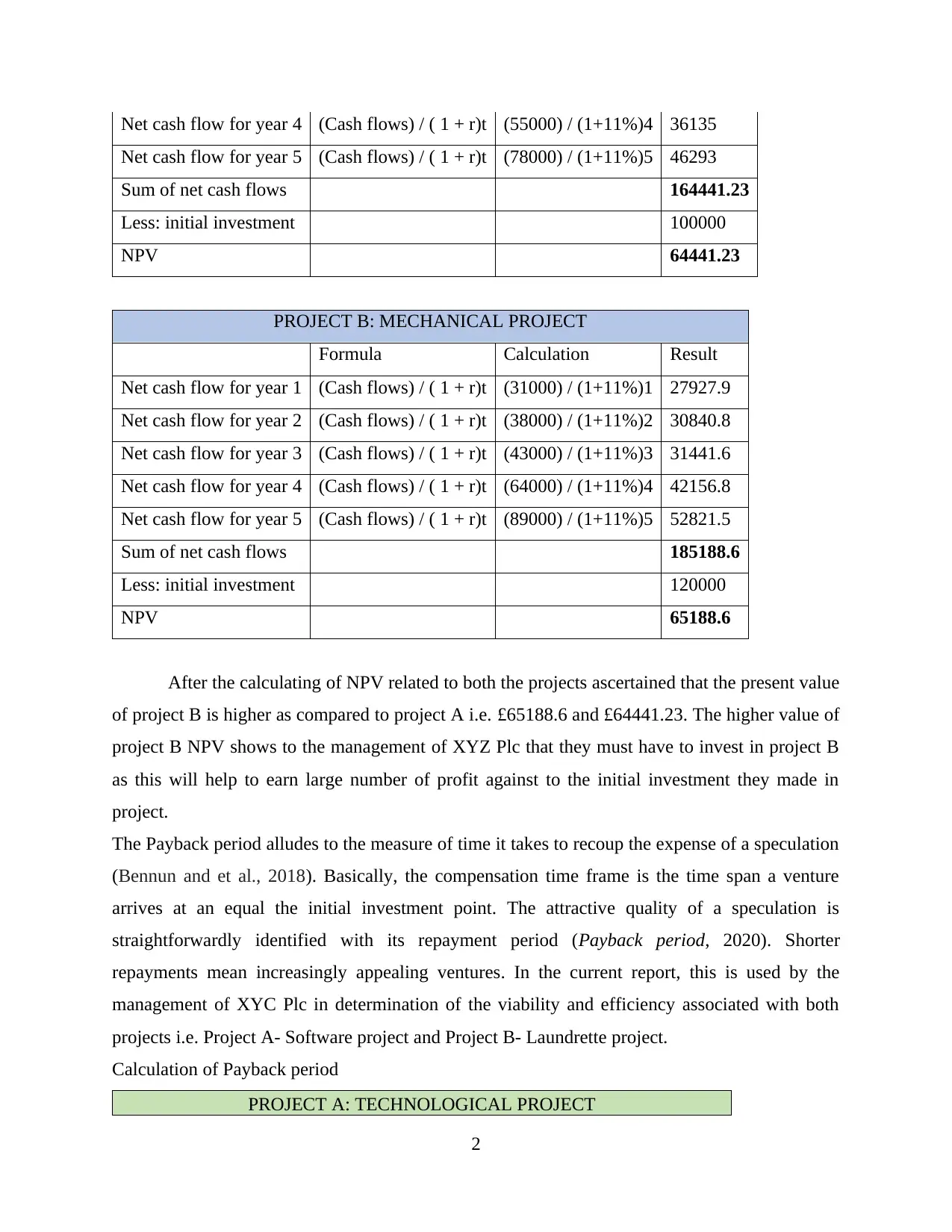
Net cash flow for year 4 (Cash flows) / ( 1 + r)t (55000) / (1+11%)4 36135
Net cash flow for year 5 (Cash flows) / ( 1 + r)t (78000) / (1+11%)5 46293
Sum of net cash flows 164441.23
Less: initial investment 100000
NPV 64441.23
PROJECT B: MECHANICAL PROJECT
Formula Calculation Result
Net cash flow for year 1 (Cash flows) / ( 1 + r)t (31000) / (1+11%)1 27927.9
Net cash flow for year 2 (Cash flows) / ( 1 + r)t (38000) / (1+11%)2 30840.8
Net cash flow for year 3 (Cash flows) / ( 1 + r)t (43000) / (1+11%)3 31441.6
Net cash flow for year 4 (Cash flows) / ( 1 + r)t (64000) / (1+11%)4 42156.8
Net cash flow for year 5 (Cash flows) / ( 1 + r)t (89000) / (1+11%)5 52821.5
Sum of net cash flows 185188.6
Less: initial investment 120000
NPV 65188.6
After the calculating of NPV related to both the projects ascertained that the present value
of project B is higher as compared to project A i.e. £65188.6 and £64441.23. The higher value of
project B NPV shows to the management of XYZ Plc that they must have to invest in project B
as this will help to earn large number of profit against to the initial investment they made in
project.
The Payback period alludes to the measure of time it takes to recoup the expense of a speculation
(Bennun and et al., 2018). Basically, the compensation time frame is the time span a venture
arrives at an equal the initial investment point. The attractive quality of a speculation is
straightforwardly identified with its repayment period (Payback period, 2020). Shorter
repayments mean increasingly appealing ventures. In the current report, this is used by the
management of XYC Plc in determination of the viability and efficiency associated with both
projects i.e. Project A- Software project and Project B- Laundrette project.
Calculation of Payback period
PROJECT A: TECHNOLOGICAL PROJECT
2
Net cash flow for year 5 (Cash flows) / ( 1 + r)t (78000) / (1+11%)5 46293
Sum of net cash flows 164441.23
Less: initial investment 100000
NPV 64441.23
PROJECT B: MECHANICAL PROJECT
Formula Calculation Result
Net cash flow for year 1 (Cash flows) / ( 1 + r)t (31000) / (1+11%)1 27927.9
Net cash flow for year 2 (Cash flows) / ( 1 + r)t (38000) / (1+11%)2 30840.8
Net cash flow for year 3 (Cash flows) / ( 1 + r)t (43000) / (1+11%)3 31441.6
Net cash flow for year 4 (Cash flows) / ( 1 + r)t (64000) / (1+11%)4 42156.8
Net cash flow for year 5 (Cash flows) / ( 1 + r)t (89000) / (1+11%)5 52821.5
Sum of net cash flows 185188.6
Less: initial investment 120000
NPV 65188.6
After the calculating of NPV related to both the projects ascertained that the present value
of project B is higher as compared to project A i.e. £65188.6 and £64441.23. The higher value of
project B NPV shows to the management of XYZ Plc that they must have to invest in project B
as this will help to earn large number of profit against to the initial investment they made in
project.
The Payback period alludes to the measure of time it takes to recoup the expense of a speculation
(Bennun and et al., 2018). Basically, the compensation time frame is the time span a venture
arrives at an equal the initial investment point. The attractive quality of a speculation is
straightforwardly identified with its repayment period (Payback period, 2020). Shorter
repayments mean increasingly appealing ventures. In the current report, this is used by the
management of XYC Plc in determination of the viability and efficiency associated with both
projects i.e. Project A- Software project and Project B- Laundrette project.
Calculation of Payback period
PROJECT A: TECHNOLOGICAL PROJECT
2
Paraphrase This Document
Need a fresh take? Get an instant paraphrase of this document with our AI Paraphraser
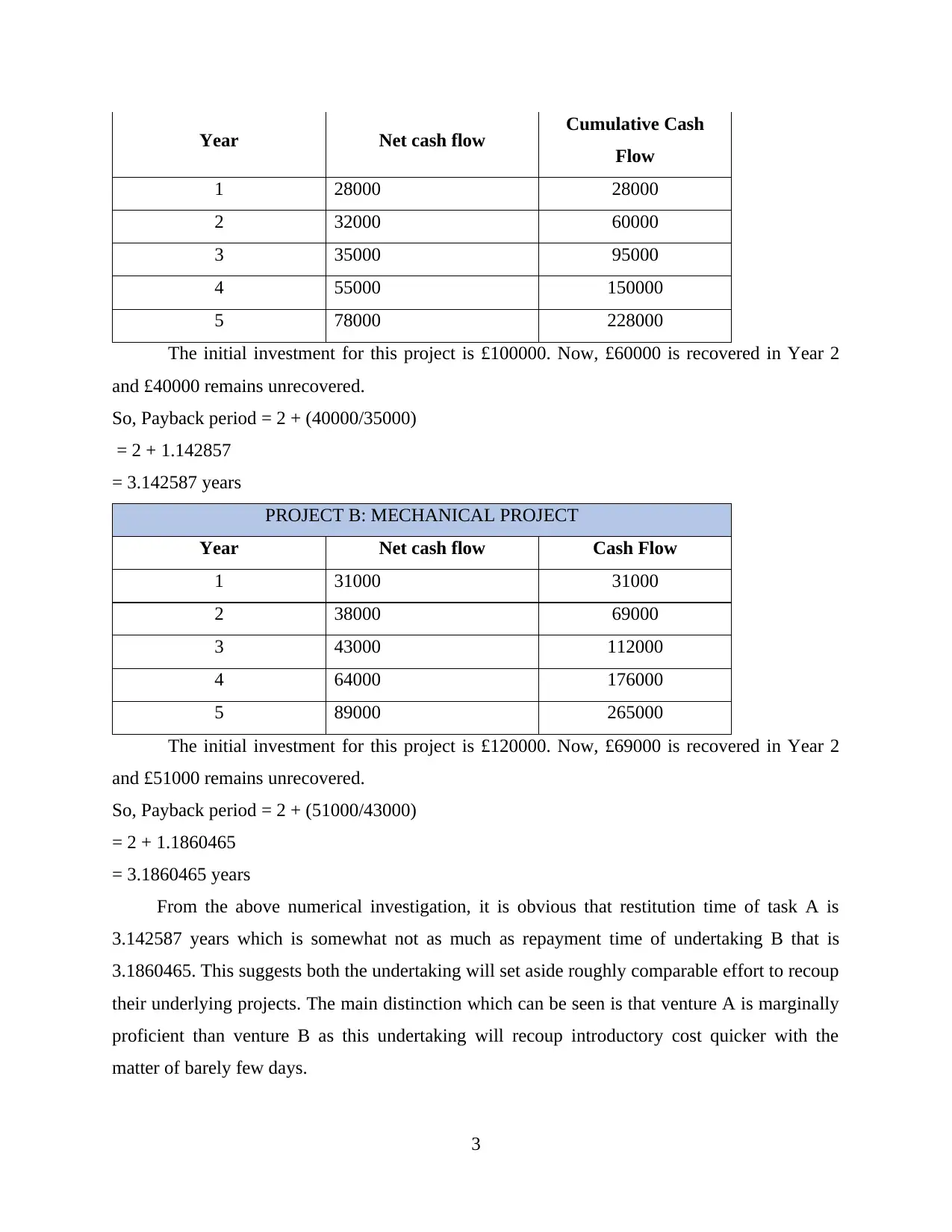
Year Net cash flow Cumulative Cash
Flow
1 28000 28000
2 32000 60000
3 35000 95000
4 55000 150000
5 78000 228000
The initial investment for this project is £100000. Now, £60000 is recovered in Year 2
and £40000 remains unrecovered.
So, Payback period = 2 + (40000/35000)
= 2 + 1.142857
= 3.142587 years
PROJECT B: MECHANICAL PROJECT
Year Net cash flow Cash Flow
1 31000 31000
2 38000 69000
3 43000 112000
4 64000 176000
5 89000 265000
The initial investment for this project is £120000. Now, £69000 is recovered in Year 2
and £51000 remains unrecovered.
So, Payback period = 2 + (51000/43000)
= 2 + 1.1860465
= 3.1860465 years
From the above numerical investigation, it is obvious that restitution time of task A is
3.142587 years which is somewhat not as much as repayment time of undertaking B that is
3.1860465. This suggests both the undertaking will set aside roughly comparable effort to recoup
their underlying projects. The main distinction which can be seen is that venture A is marginally
proficient than venture B as this undertaking will recoup introductory cost quicker with the
matter of barely few days.
3
Flow
1 28000 28000
2 32000 60000
3 35000 95000
4 55000 150000
5 78000 228000
The initial investment for this project is £100000. Now, £60000 is recovered in Year 2
and £40000 remains unrecovered.
So, Payback period = 2 + (40000/35000)
= 2 + 1.142857
= 3.142587 years
PROJECT B: MECHANICAL PROJECT
Year Net cash flow Cash Flow
1 31000 31000
2 38000 69000
3 43000 112000
4 64000 176000
5 89000 265000
The initial investment for this project is £120000. Now, £69000 is recovered in Year 2
and £51000 remains unrecovered.
So, Payback period = 2 + (51000/43000)
= 2 + 1.1860465
= 3.1860465 years
From the above numerical investigation, it is obvious that restitution time of task A is
3.142587 years which is somewhat not as much as repayment time of undertaking B that is
3.1860465. This suggests both the undertaking will set aside roughly comparable effort to recoup
their underlying projects. The main distinction which can be seen is that venture A is marginally
proficient than venture B as this undertaking will recoup introductory cost quicker with the
matter of barely few days.
3
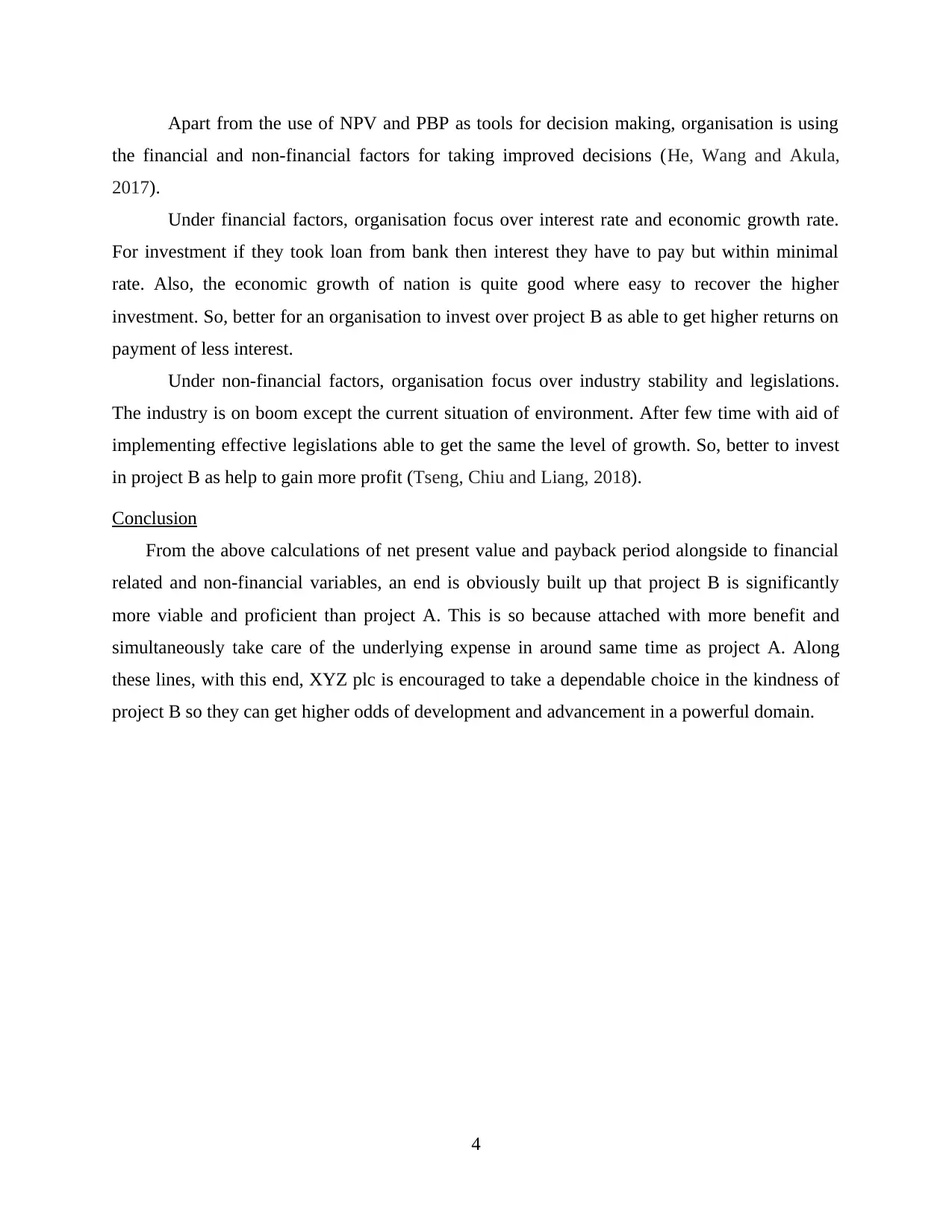
Apart from the use of NPV and PBP as tools for decision making, organisation is using
the financial and non-financial factors for taking improved decisions (He, Wang and Akula,
2017).
Under financial factors, organisation focus over interest rate and economic growth rate.
For investment if they took loan from bank then interest they have to pay but within minimal
rate. Also, the economic growth of nation is quite good where easy to recover the higher
investment. So, better for an organisation to invest over project B as able to get higher returns on
payment of less interest.
Under non-financial factors, organisation focus over industry stability and legislations.
The industry is on boom except the current situation of environment. After few time with aid of
implementing effective legislations able to get the same the level of growth. So, better to invest
in project B as help to gain more profit (Tseng, Chiu and Liang, 2018).
Conclusion
From the above calculations of net present value and payback period alongside to financial
related and non-financial variables, an end is obviously built up that project B is significantly
more viable and proficient than project A. This is so because attached with more benefit and
simultaneously take care of the underlying expense in around same time as project A. Along
these lines, with this end, XYZ plc is encouraged to take a dependable choice in the kindness of
project B so they can get higher odds of development and advancement in a powerful domain.
4
the financial and non-financial factors for taking improved decisions (He, Wang and Akula,
2017).
Under financial factors, organisation focus over interest rate and economic growth rate.
For investment if they took loan from bank then interest they have to pay but within minimal
rate. Also, the economic growth of nation is quite good where easy to recover the higher
investment. So, better for an organisation to invest over project B as able to get higher returns on
payment of less interest.
Under non-financial factors, organisation focus over industry stability and legislations.
The industry is on boom except the current situation of environment. After few time with aid of
implementing effective legislations able to get the same the level of growth. So, better to invest
in project B as help to gain more profit (Tseng, Chiu and Liang, 2018).
Conclusion
From the above calculations of net present value and payback period alongside to financial
related and non-financial variables, an end is obviously built up that project B is significantly
more viable and proficient than project A. This is so because attached with more benefit and
simultaneously take care of the underlying expense in around same time as project A. Along
these lines, with this end, XYZ plc is encouraged to take a dependable choice in the kindness of
project B so they can get higher odds of development and advancement in a powerful domain.
4
⊘ This is a preview!⊘
Do you want full access?
Subscribe today to unlock all pages.

Trusted by 1+ million students worldwide
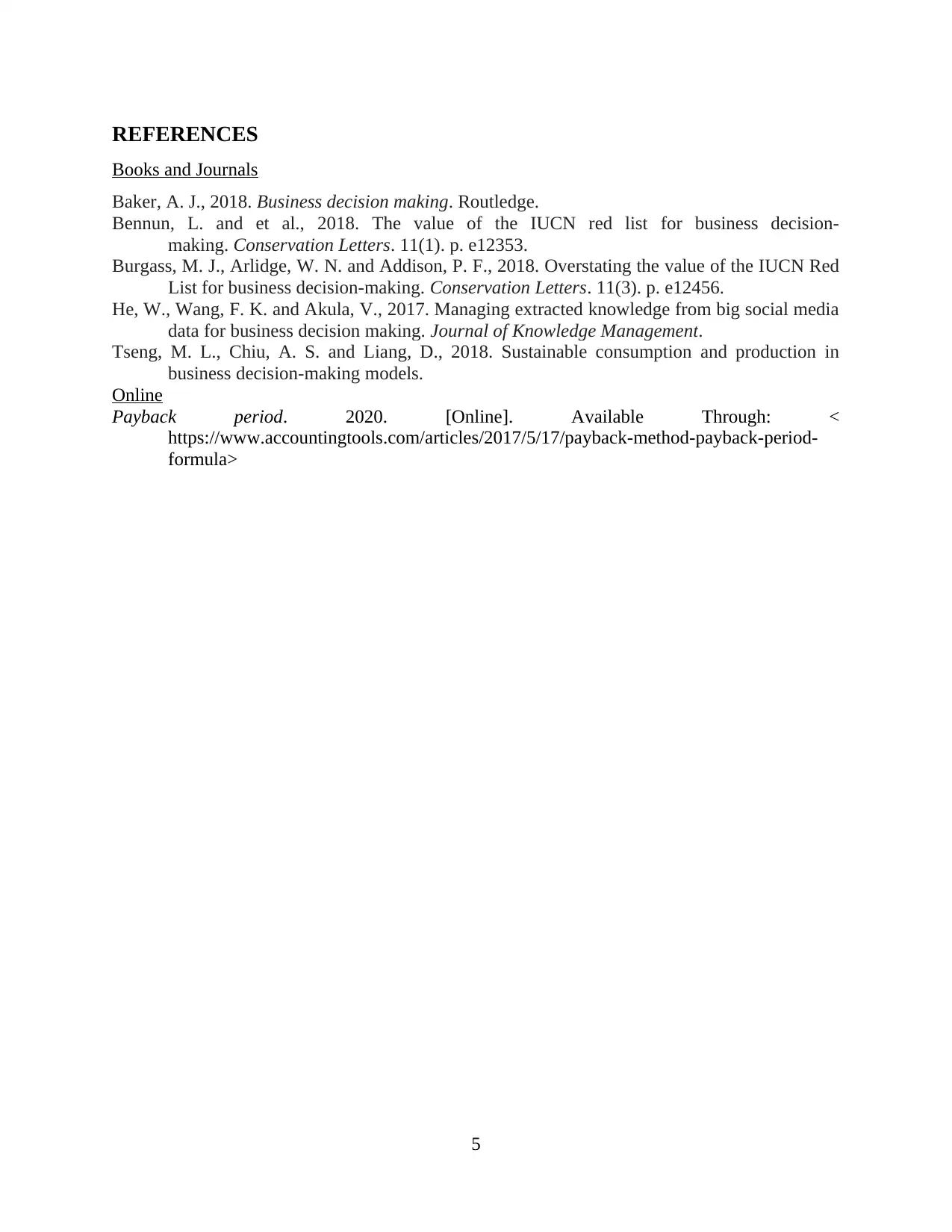
REFERENCES
Books and Journals
Baker, A. J., 2018. Business decision making. Routledge.
Bennun, L. and et al., 2018. The value of the IUCN red list for business decision‐
making. Conservation Letters. 11(1). p. e12353.
Burgass, M. J., Arlidge, W. N. and Addison, P. F., 2018. Overstating the value of the IUCN Red
List for business decision‐making. Conservation Letters. 11(3). p. e12456.
He, W., Wang, F. K. and Akula, V., 2017. Managing extracted knowledge from big social media
data for business decision making. Journal of Knowledge Management.
Tseng, M. L., Chiu, A. S. and Liang, D., 2018. Sustainable consumption and production in
business decision-making models.
Online
Payback period. 2020. [Online]. Available Through: <
https://www.accountingtools.com/articles/2017/5/17/payback-method-payback-period-
formula>
5
Books and Journals
Baker, A. J., 2018. Business decision making. Routledge.
Bennun, L. and et al., 2018. The value of the IUCN red list for business decision‐
making. Conservation Letters. 11(1). p. e12353.
Burgass, M. J., Arlidge, W. N. and Addison, P. F., 2018. Overstating the value of the IUCN Red
List for business decision‐making. Conservation Letters. 11(3). p. e12456.
He, W., Wang, F. K. and Akula, V., 2017. Managing extracted knowledge from big social media
data for business decision making. Journal of Knowledge Management.
Tseng, M. L., Chiu, A. S. and Liang, D., 2018. Sustainable consumption and production in
business decision-making models.
Online
Payback period. 2020. [Online]. Available Through: <
https://www.accountingtools.com/articles/2017/5/17/payback-method-payback-period-
formula>
5
1 out of 7
Related Documents
Your All-in-One AI-Powered Toolkit for Academic Success.
+13062052269
info@desklib.com
Available 24*7 on WhatsApp / Email
![[object Object]](/_next/static/media/star-bottom.7253800d.svg)
Unlock your academic potential
Copyright © 2020–2025 A2Z Services. All Rights Reserved. Developed and managed by ZUCOL.





